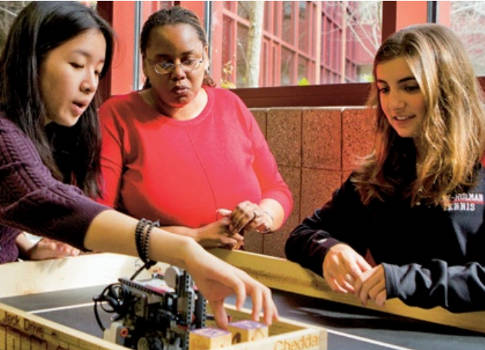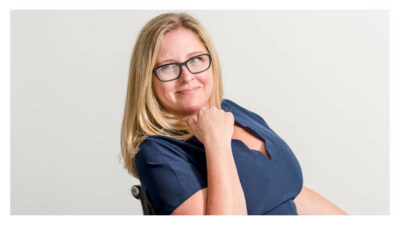Rethinking ways to attract and retain African-American women in academic engineering — while understanding the intersection of race and gender — has never been more important. These women are showing the way.

One of the biggest trends in the workplace today is for employees and entrepreneurs to create a “brand” — a reputation, and preferably a multimedia one — as an expert, a leader, a go-getter, and a deep thinker. Monica F. Cox, Ph.D., a nationally acclaimed engineering professor and the only African-American female to earn tenure at Purdue University’s College of Engineering, looks to Oprah, one of the earliest and most successful multimedia brand builders, as an example for the next generation’s successful engineers and engineering professors.
Oprah’s original, fearless branding strategy is at the heart of the four social media- and multimedia-based initiatives that form Dr. Cox’s own multitiered brand, “Prepared to Be a Pioneer.TM” Developing this brand is part of her mission to attract more African-American women into engineering academia in a whole new way. “It’s not just about STEM,” said Dr. Cox, who is under contract with Elsevier publishing company to write a book about “demystifying” the engineering Ph.D. “It’s connecting people outside of their traditional fields. For example, Oprah is not a psychologist or businessperson by training. She transcended (defined roles) and excels in fields in which she had no formal training. That’s who I want to be.”
A Sense of Urgency
Attracting African-American women into the academic world of engineering has never been more critical, as evidenced both by headline-grabbing news and by digging a bit deeper beyond the headlines. For example, the National Science Foundation (NSF) reports that STEM women faculty make up 58 percent and 46 percent of the scientists and engineers in two- and four-year institutions, respectively. This reflects a dramatic increase over the 30 percent level reported in 2006. Closer examination of the data, however, reveals that women remain disproportionately underrepresented in some STEM disciplines, such as engineering and physics. In addition, within the ranks of STEM faculty, women of color are woefully underrepresented, accounting for less than 2 percent of the faculty of U.S. institutions of higher education at four-year colleges and universities, even though they make up almost 16 percent of bachelor’s of science and 7 percent of Ph.D. recipients in STEM fields.
As for engineering professors specifically, the American Society for Engineering Education reports that, as of 2011, African-American women made up 4 percent of all women in the engineering professoriate. Between 2001 and 2012, the number of African-American engineering faculty members increased from 2 percent to 3 percent. In all, in 2012 there were 140 African-American women working as engineering professors — out of some 24,640 across the entire discipline (not including computer engineering).
A poll published Oct. 22 revealed that nearly half (49 percent) of all U.S. women are now the primary breadwinners or are on par financially with their significant others, yet the vast majority of female breadwinners reported they do not feel in control of their destinies, nor have their careers given them a greater sense of purpose. The survey of 2,589 women in the United States, the U.K., China, and Germany was conducted by public-relations firm Ketchum and social-media network BlogHer. Indeed, among female primary breadwinners in the United States, 44 percent said they are more stressed than they were five years ago, and 42 percent have less free time.
Now, as never before, colleges and universities are under intense scrutiny for their policies regarding women and sexual harassment. The New York Times noted in a front-page story Nov. 2 that a harassment scandal involving one of the nation’s leading medical schools, Yale, comes as the federal government is scrutinizing dozens of colleges for their handling of sexual misconduct allegations against students.
At the same time, best-selling author Glenn Llopis says in his new e-book, Preparing U.S. Leadership for the Seismic Cultural Demographic Shift, that ensuring diversity is “no longer just a numbers game” because the country’s African-American, Hispanic, and Asian-Pacific populations already have surpassed one-third of the U.S. population and are on track to reach 54 percent by 2050. Llopis says that in the corporate world alone, nondiverse executives and board members are not “culturally intelligent” enough to see the impact that this cultural shift has on their employees, suppliers, and consumers, or to meet these populations’ uniquely different needs.In a similar vein, Dr. Cox and other African-American women in academia say it’s still routine to be judged by the way they dress and wear makeup, and to be called by their first names, rather than addressed as “doctor” or “professor,” even though students seldom mention their white male colleagues’ appearances and refer to the male professors with honorary titles. “I wanted to talk to someone about whether I was being overly sensitive, whether I should provide ‘teachable’ moments or whether I should just ignore the comments,” Dr. Cox said. “Over time, the professional demands of my job, coupled with these incidents, started to affect my mental and physical health.”
Llopis says today’s leaders must consider the strategic implications of “cross-cultural intelligence, diversity of thought, and the rapidly evolving insights from the changing face of America’s work force and consumers.” Not recognizing the significance of these shifts — or the immediate and longerterm implications that accompany them — creates all kinds of friction, he says. Indeed, one African-American engineering professor who asked not to be named said her colleagues had mistaken her at different times for a janitor who worked in the building and for another African-American female professor in the department.
A Variety of Antidotes
Participants in the STEM Women of Color Conclave — a professional network — recently created the Society of STEM Women of Color, a 501c3 nonprofit association. This new organization is committed to ensuring that the unique experiences of women of color, as well as their cultural contexts, are accurately examined and reported in peer-reviewed articles in scientific and engineering journals, said Kelly Mack, Ph.D. As vice president of undergraduate STEM education at the Association of American Colleges & Universities (AAC&U), based in Washington, D.C., and a founding member of the society, Dr. Mack explained that, “Our first step is to make people aware of the intersection of race and gender, and the role it plays in decision making.”
To achieve the goal, the organization aims to build the collective intelligence of STEM women faculty of color, particularly around best practices for recruiting and retaining diverse STEM faculty, Dr. Mack said. “We as a nation can no longer rely solely on social-justice arguments about diversity being the right thing to do,” she continued. “We want to express the value of diversity in terms of evidence that indicates it leads to better research outcomes.” To do this, the AAC&U will continue to host its annual conclave for STEM women of color and will use its influence to promote better data analysis on women in STEM, as well as provide opportunities for STEM women faculty of color to connect and collaborate, Dr. Mack said.
Another example of a professional development opportunity for STEM women faculty of color is the Opportunities for UnderRepresented Scholars (OURS) program, based at the Chicago School of Professional Psychology. OURS runs a yearlong leadership development program for women of color in which the women earn a graduate certificate in academic leadership. The NSF has provided $2.2 million toward the effort. “They are actually gaining a credential that can be used to catapult them into leadership positions on their campuses,” Dr. Mack said.
The program provides executive coaching and a thorough investigation of higher-education literature grounded in cultural contexts that are relevant to experiences either in their lives or at historically black colleges and universities. The program, which the participants do online and in short residency periods at the School of Professional Psychology’s Washington, D.C., campus, has recently been expanded to include Native American women.
The first group of 15 finished the program in spring 2014. From this initial group, 25 percent were promoted to leadership positions at their colleges or universities while they were still enrolled in the program, Dr. Mack said. “Our long-term goal is to enhance the climate for women of color so that they are able to thrive in the academic world,” she said. “In the short term, we want to raise awareness about the uniqueness of these women’s experiences and empower women of color to lead within the ever-changing landscape of STEM higher-education reform,” Dr. Mack added.
It’s that kind of top-down, strategic rethinking that Dr. Cox would like to see more of. She is working on it from both inside and outside academia, as witnessed by her initiatives to create new leadership degrees, tools, and even entertainment. At Purdue, she is in charge of a new engineering leadership minor, a 16-credit course of study that encourages engineering students to concentrate on ethics; creativity and innovation; the global and societal impacts of their decisions; and other nontraditional issues. She also serves as director of the International Institute for Engineering Education Assessment (i2e2a).
On other fronts, Dr. Cox started her own company, STEMinent LLC, which seeks to license and commercialize her innovations, including The G-RATE, a Global Real-Time Assessment Tool for Teaching Enhancement that lets teachers track the time they spend on tasks such as classroom organization and how they engage with students in classroom observations. She also created the Quirky Time (@QuirkyTime) YouTube channel, featuring an animated series exploring the lives and eccentricities of a multicultural research group that just happens to be into STEM. And she co-authored a publication about socialmedia branding with entrepreneur Paul C. Brunson, co-host of “Our World with Black Enterprise.” Brunson is serving as Dr. Cox’s entrepreneurial mentor and research collaborator.
Dr. Cox, who earned the Presidential Early Career Award for Scientists and Engineers (PECASE) in 2008 and received the award from President Obama in January 2010, attended such a small, rural high school in Alabama that she had taken no calculus or advanced placement classes before winning a Women in Science and Engineering (WISE) scholarship to attend Spelman College. She was one of 13 women in the 1994 WISE program who went to classes together, lived in the same dorm at Spelman, and were supported with resources and tutorials to adopt STEM careers.
She was encouraged by one of her mentors, the late Etta Zuber Falconer, Ph.D., a WISE program director and one of the nation’s first African-American women to earn a Ph.D. in mathematics and to become a college mathematics teacher. Recalling their relationship, Dr. Cox noted that Dr. Falconer remembered how she (Cox) cried and struggled to catch up during the WISE summer program, which was sponsored by NASA. During the program, students were required to learn an entire semester’s content in six weeks and pass tests that would determine their placement in first-year college STEM courses.
Instead of being turned off by Dr. Cox’s early emotions, Dr. Falconer focused on encouraging her to continue her studies in engineering. Not only did she persevere, but Dr. Cox also earned her master’s degree in industrial engineering from the University of Alabama (Tuscaloosa) and her Ph.D. in leadership and policy studies from Vanderbilt University in Nashville, Tennessee.
In 2011, Dr. Cox became — and remains — the first and only AfricanAmerican female professor to earn tenure in Purdue’s College of Engineering. She was one of 20 PECASE winners in 2010 from among more than 4,000 applicants of the Faculty Early Career Development (CAREER) program sponsored by the NSF.
Her proposal: What can be done to prepare more people to obtain Ph.D.s in academic and nonacademic engineering careers, and to find out more about the engineering Ph.D. process itself. The proposal led to her book contract with Elsevier publishing company to write about demystifying the engineering Ph.D.
What makes women stay?
Indeed, studies show that female professors — the most obvious mentors to female engineering students — play a critical role in the student’s decision to persevere. That’s why one researcher, Joyce Main, Ph.D., an assistant professor in engineering education at Purdue University, is working to increase the diversity of engineering graduate students and faculty members. Her agenda includes exploring how female engineers from the private sector can find new and more fluid ways to move into leadership roles in academe.
“It’s really important that the people working on the world’s challenges come from a variety of backgrounds,” Dr. Main said. “The types of problems that a diverse group pursues is more representative of what the population as a whole would benefit from.”
Dr. Main obtained her undergraduate degree in biology from the University of California, Berkeley and earned her master’s and Ph.D. in education from the Harvard Graduate School of Education and Cornell University, respectively. At Cornell, she worked with renowned labor economist Ronald G. Ehrenberg, Ph.D., director of the university’s Higher Education Research Institute.
An Asian-American who is on a tenure track, Dr. Main has performed studies that show women are more likely to complete Ph.D.s in science, engineering, and mathematics when they are enrolled in departments that have relatively higher proportions of female faculty. The specific results have not yet been published. Her research also revealed that female doctoral students advised by female faculty in these fields are more likely to graduate than those advised by male faculty. Dr. Main said she found that the results were unique to female doctoral students because the proportion of female faculty and the gender of the faculty dissertation advisor had no effect on male graduate students’ likelihood that they will finish their Ph.D.s.
That’s why Dr. Main hopes to recommend new ways in which highereducation institutions enable engineers to become faculty members. “Engineering Ph.D.s with industry experience can bring valuable expertise into the classroom and to academic research,” she said. “They can provide important perspectives and help students develop skills critical to working in industry.
These unique contributions are particularly important given that a large proportion of undergraduate students gain postgraduate jobs in industry and because there is growing attention on how to prepare students for different types of careers.
“This can also facilitate another potential pathway for diversifying the faculty by increasing the pool from which we can recruit more engineering Ph.D.s from a broad range of backgrounds to become tenure-track faculty members,” she said. Dr. Main’s earlier research at Cornell revealed that academic institutions with women in leadership positions — presidents, provosts, and boards of trustees with at least 25 percent women — increased their share of female faculty at a more rapid rate than did other institutions.
The 2012 study used a large sample of institutions, a long time frame, and a methodology that sought to account for other factors in hiring, parameters that could provide new evidence to those who argue that change at the top of institutions is crucial to promoting change at the junior faculty ranks as well. Among the findings:
- Institutions with female presidents, female provosts (or academic vice presidents), and more women on boards of trustees saw larger increases in the share of female faculty members than did other institutions.
- The magnitude of the impact of women in these high leadership positions was greater at smaller institutions, which the report suggests may be due to those being institutions “where central administrators may play a greater role in faculty hiring decisions.”
- The impact of having more women as trustees was apparent only when a critical mass had been reached, either of the female proportion on the board (25 percent) or the number of women on the board.
The study cites a separate report on the hiring of women in science fields, noting that the presence of women in certain positions might send signals to applicants. “The report of a recent National Research Council committee, upon which one of us served, found evidence that the gender of the chair of a faculty search committee in science and engineering fields at major research universities influences the likelihood that female Ph.D.s will apply for the position; apparently knowledge of the gender of the chair of the search committee signals something to potential female applicants about the seriousness of the department in wanting to expand female faculty employment and in providing leadership opportunities for female colleagues,” the study indicated.
Dr. Main is looking to Purdue’s example of welcoming private-sector engineers into the College of Engineering to help students learn the skills they will need to get jobs. One method that appears successful in retaining women is to focus on a social “good,” such as working on projects to help people or maintaining high ethical standards in real-world situations, Dr. Main said.
Another idea is to encourage engineering students to think more broadly about their “mentors” and include in that definition one’s peers, family, and school friends from the past, she said.
Carlotta A. Berry, Ph.D., associate professor of electrical and computer engineering at Rose-Hulman Institute of Technology in Terre Haute, Indiana, is seeking to expand the ROSE-BUD program that aims to increase diversity among college students majoring in computer science, computer, electrical, and software engineering. The acronym ROSE-BUD stands for Rose Building Undergraduate Diversity. Dr. Berry started it in 2008 with a colleague, Deborah Walter, Ph.D., assistant professor in the department of electrical and computer engineering.
The program received initial support from a $600,000 NSF grant. Funding for the program will end in June 2015. Dr. Berry plans to seek more funding for the program from NSF and other sources to expand across the institute next academic year. The program provides financial support, advising, mentoring, networking, and professional development to students majoring in those specific disciplines, with emphasis on recruiting, retaining, and developing women and underrepresented minorities in STEM fields.
The goal is to create networks and a community to better coordinate today’s disjointed efforts to attract women of color to STEM fields, said Dr. Berry, who had no engineering role models when she majored in electrical engineering at the Georgia Institute of Technology in the early 1990s. “The networking, mentoring, and coaching are designed to say, ‘You’re valuable. You are important and we need you here,’” she said.
This article originally appeared on SWE. SWE is a CFE Media content partner. Edited by Ksenia Avrakhova, production coordinator, CFE Media, [email protected].



